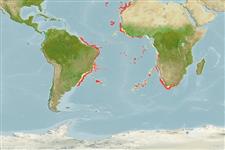分類 / Names
共通名の | 類義語 | Catalog of Fishes(部類, 種) | ITIS | CoL | WoRMS | Cloffa
板鰓亜鋼(サメとエイ類) (sharks and rays) >
Squaliformes (Sleeper and dogfish sharks) >
Somniosidae (Sleeper sharks)
Etymology: Centroscymnus: centr[um] (L.), prickle or sharp point, referring to spines on both dorsal fins; scymnus, an ancient name for some kind of shark, derived from a Greek word meaning young animal, cub or whelp (See ETYFish); owstonii: In honor of Alan Owston (1853-1915), English businessman, yachtsman, and collector of Asian wildlife, who obtained holotype (See ETYFish).
Eponymy: Alan Owston (1853–1915) was an English businessman who was a collector of Asian wildlife, as well as a yachtsman. [...] (Ref. 128868), visit book page.
More on author: Garman.
Environment: milieu / climate zone / depth range / distribution range
生態学
海 深海魚; 深さの範囲 100 - 1500 m (Ref. 26346). Deep-water; 33°N - 38°S, 52°W - 30°E
Atlantic, Pacific and Indian oceans. Western Indian Ocean: from off the Seychelles to the Madagascar Ridge and South Africa. Eastern Indian Ocean off Indonesia and southwestern Australia. Southwestern Pacific: off Australia, New Caledonia and New Zealand. Northwestern Pacific: off Japan and from the Hawaiian-Emperor seamount chain. Southeastern Pacific: west of Chile. Southwestern Atlantic: off French Guiana, Brazil, and Uruguay. Northwestern Atlantic: Gulf of Mexico. Eastern Atlantic: from off the Azores in the North to off South Africa in the south.
Length at first maturity / サイズ / 重さ / 年齢
Maturity: Lm ?, range 100 - 104 cm
Max length : 148 cm TL オス/雌雄の選別がない; (Ref. 122636); 最大公表体重: 21.3 kg (Ref. 122636)
肛門の骨: 0. Dark brown or black in color, dorsal fins with extreme tips of fin spines protruding from the fins, moderately long snout, lanceolate upper teeth and bladelike lower teeth with short, oblique cusps, fairly stocky body that does not taper abruptly from pectoral region, large lateral trunk denticles with mostly smooth, circular, cuspidate and acuspidate crowns in adults and subadults (Ref. 247).
Found on upper continental slopes, on or near the bottom (Ref. 247). Feeds on fish and cephalopods (Ref. 6871). Ovoviviparous (Ref. 205), with 16- 28 young born at 27-30 cm (Ref. 26346). Caught in trawls or longlines set at depths greater than 400 m (Ref. 55584). Flesh is high in mercury (Ref. 6871). Utilized as fishmeal and source of squalene (liver oil) (Ref. 6871). Maximum depth from Ref. 55584.
Life cycle and mating behavior
成熟 | 繁殖 | 放精 | 卵 | 生産力 | 幼生
Ovoviviparous (Ref. 6871). 16- 28 young born at 27-30 cm (Ref. 26346). Distinct pairing with embrace (Ref. 205).
Compagno, L.J.V., 1984. FAO Species Catalogue. Vol. 4. Sharks of the world. An annotated and illustrated catalogue of shark species known to date. Part 1 - Hexanchiformes to Lamniformes. FAO Fish. Synop. 125(4/1):1-249. Rome, FAO. (Ref. 247)
IUCNのレッドリストの状況は (Ref. 130435: Version 2024-1)
人間に対する脅威
Poisonous to eat (Ref. 6871)
Human uses
水産業: 少数商業の
用具
特記事項
XMLをダウンロードして下さい
インターネットの情報源
Estimates based on models
Preferred temperature (Ref.
123201): 4.9 - 10.9, mean 6.4 °C (based on 66 cells).
Phylogenetic diversity index (Ref.
82804): PD
50 = 0.5313 [Uniqueness, from 0.5 = low to 2.0 = high].
Bayesian length-weight: a=0.00324 (0.00196 - 0.00534), b=3.16 (3.03 - 3.29), in cm total length, based on LWR estimates for this species & (Sub)family-body (Ref.
93245).
栄養段階 (Ref.
69278): 4.5 ±0.62 se; based on food items.
回復力 (Ref.
120179): 低い, 4.5年~14年の倍増期間の最小個体群 (Fec=16-28).
Fishing Vulnerability (Ref.
59153): Very high vulnerability (89 of 100).
Climate Vulnerability (Ref.
125649): Moderate vulnerability (38 of 100).
